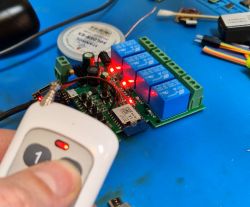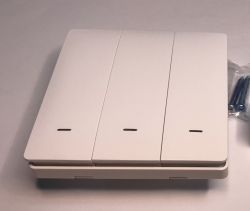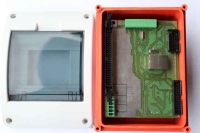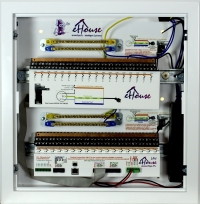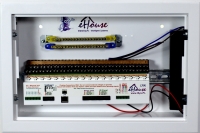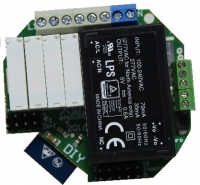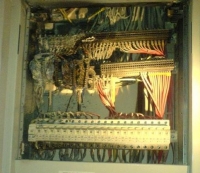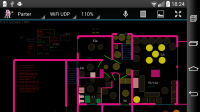 .
.
 .
.
Tutorial on how to choose a "Smart Building" system. PDF .
Building Automation with self-installation and development (DIY).
.
Building Automation with self-installation and development (DIY).
In this guide you can read about the „behind-the-scenes” systems Intelligent Building (IB) , helping you to select a developmental system for years to come.
Content Description of the Guide:
.
General information on IB systems: .
1) Life expectancy of the IB system
2) Expansion of the system – after the house is finished
3) Total functionality of the IB system
4) Ability to integrate IB with external hardware and other devices
5) Available communication interfaces and protocols for possible IB system integration
6) Total costs and benefits of the IB system
7) Paid and mandatory technical maintenance, available updates, possibility of self-configuration
(8) Stability and robustness of the system
eHouse DIY – Integrated system „All-in-one” : wired | wireless, for switchgear | boxes | OEM:
9) Integrated BMS assumptions - eHouse Hybrid (PRO, LAN, RS-485, CAN, WiFi, RF)
10) Communication and installation options eHouse Building Automation
11) General functionality of eHouse building automation
12) Comparison of major IB system variants eHouse (LAN, RS-485, WiFi, PRO)
13) Pictures eHouse LAN (DIY), accessories, switchgear 18-32 outputs 230V/16A
14) eHouse PRO – professional central distribution board 128 inputs / 128 outputs
15) eHouse WiFi – wireless controllers
16) Modules DIY2 for hobbyists „do it yourself”: IOT (ESP8266), SPI I/O buffers, I2C for RPI1/2/3 | BananaPRO
Input. .
Nowadays, there is a large selection of „intelligent systems” for the home or flat on the market.It is worth choosing a building automation system more consciously according to your needs and requirements, especially since it is to last for at least a dozen years. Therefore, let us not be guided by the lowest price, a nice control panel or a remote control application. Let's choose a system that is functional, stable and open for the future. modifications, because our expectations change, technologies change - and this usually means additional development costs, much higher than the same elements at the planning stage of the IB system.
„smart home” systems are largely treated like an expensive gadget in Poland and boil down to remote control of a light or socket. Many manufacturers overuse the word „intelligent” which has distorted the understanding of this phrase somewhat (e.g. an ordinary switch with backlighting is already an intelligent switch according to the manufacturer's description).
Building automation should, on the other hand, fulfil many practical functions: increase safety, help save electricity and heating, flexibly manage heating or increase the comfort of the home. It should partially work autonomously once configured, performing certain actions without user intervention, and not just allow manual remote control from a panel or smartphone.
There are many „Smart Home” systems on the market:
- cheap, market solutions (of the „Price Does Wonders”) type that do not offer the possibility of any integration or development (they often disappear from the market after 2-3 years and have a lifespan similar to the warranty period, as low-life components are used to keep the price to a minimum),
- expensive systems based on well-known standards/brands (we pay mainly for the logo, advertising and prestige and services, and extending the system costs as much as the basic version),
- systems that allow integration and expansion and self-development (DIY).
When selecting an IB system, it is also important to consider:
- the average lifetime of the system,
- the possibility of expansion,
- the total functionality of the entire system,
- the possibility of integration with external hardware and other devices,
- available communication interfaces and protocols for possible integration with external systems,
- costs and benefits of the IB system,
- available updates,possibility of self-configuration,
- stability and robustness of the system.
Read More .
1. IB system life expectancy 1.
The average lifetime of a system is influenced by many factors, e.g. the technology used and miniaturisation.
- for systems mounted in electrical boxes and small enclosures, it is necessary to use miniature relays, which are many times less robust than standard or industrial ones,
- due to the lack of ventilation, controllers can also overheat, which significantly reduces their lifetime,
- radio circuits „lose” their parameters, so that their range deteriorates significantly, mainly due to the loss of capacitor capacitance over time,
- controllers operating on a serial bus without galvanic isolation are very vulnerable to overvoltages and the resulting damage and destruction of the entire system in the event of a voltage surge (e.g. lightning strike or short-circuit of the bus to 230V mains voltage).
More information .
2. Extending the system – after the house is finished .
Most electrical designs are minimalist, especially in blocks of flats, which is very non-functional and severely limits the ability to position appliances in the home. In order to be able to afford possible future redecoration of the flat, rearrangement of electrical appliances, computer, A/V equipment, it is necessary to make additional electrical points (electrical sockets, sidelights or leave the wires in a masked electrical box or under the plaster) and RTV wiring. Otherwise our house will be dominated by electrical distributors and cables stretched across the rooms.
Deep (60mm) electrical boxes potentially accommodating automation electronic modules should be used for installation.
This generates additional costs for us at the beginning, but once the house is finished, the cost of adding the cable increases by several dozen times, taking into account the need to chisel walls, plaster and repaint.
The way the electrical wiring is laid out in the rooms is also important.
In order to allow for the installation of almost any system in the future, all wiring should be brought into the room distribution box as in the example eHouse LAN . This will allow us to use both radio trunking systems (e.g. eHouse WiFi ) and wired systems installed in switchboards.
As a basic system, we ALWAYS recommend wired systems for small switchboards, and only as non-critical system extensions - wireless (dimmers, temperature sensors, etc.), and battery solutions only as a last resort. .
3. Total IB system functionality .
Smart home systems have different functionality and capabilities. Systems „non-developmental” and without integration capabilities are much cheaper than those that allow integration and expansion. For example, smart sockets with infrared remote control can be purchased cheaply in markets, but cannot be controlled from outside the home. A distinction can be made between:Control: Local (at home) / Remote (via internet)
- Types of smart points:
* on/off inputs – connection of switches, alarm sensors,
* measurement inputs: connection of sensors (temperature, lighting, humidity, gas),
* on/off outputs – connection of electrical devices,
* dual outputs (open/stop/close) – to control roller shutter drives, gates, etc..,
* dimmers – regulation of lighting levels,
* infrared receiver – for controlling the IB system from an infrared remote control,
* infrared transmitter - to control external devices (e.g. audio-video),
- Control panels: infrared remote controls, smartphone/tablet/SmartTV, PC, WWW, switches,
- Additional functionality: light scenes, heating programmes, schedule-calendar, drive programmes, security zones, alarm, access control, reports, macros, advanced algorithms, visualisations, etc.
Please note that the price of selected options is „prohibitive” in some systems:
e.g.. dedicated operator panels, dimmers, dedicated switches with communication interfaces, etc.
4. Ability to integrate with external hardware and other devices .
Gone are the days that we build a house and nothing will change for a dozen years or so. Technology changes so quickly and with it our needs and expectations that we will certainly want to add something to the system in a few years' time without replacing it altogether. That is why it is necessary to use development systems that provide additional capabilities and allow for the integration of external (future necessary devices).
In order to integrate the system with other devices, it must have external communication interfaces and transmission protocols (open) that allow the system to be managed from the outside and to manage other devices.
Ideally, the system should have wired and wireless extensions integrated with each other into a coherent whole.
5. Main communication interfaces and protocols for possible IB system integration .
The number of available control/management methods, communication interfaces for integration (with a publicised transmission protocol) will determine the ease and cost of integration with external systems:
- Infrared (easy integration with Audio/Video equipment)
- BlueTooth
- WiFi, Ethernet, Internet (*)
- RS-232, RS-485
- GSM/SMS .
- RF
- HTML Request (WWW) (*)
- Modbus (TCP/IP *)
- TCP/IP Client/Server (*)
- File system, ftp, email (*)
- etc.
Methods marked with (*) are particularly advantageous as they do not require additional hardware (communication gateways, interfaces, adapters, power supplies) or the need for knowledge of electronics. These methods allow software integration into systems.
Read More .
6. Total costs and benefits of the IB system. .
The costs associated with a Building Automation system should be looked at in the long term (several years).
Therefore, it is worth summarising:
- the cost of a smart point of various types (not only the final price of the system),
- the cost of IB controllers and mounting accessories, batteries and their average lifetime,
- some battery radio devices (e.g. temperature sensors) have batteries soldered in, making it impossible to replace them. It is necessary to purchase and replace the entire device with a new one and reconfigure the system due to different device addresses. Ordering a device with the same address as before costs several times more than for a new address,
- the cost of cabling and wiring (central switching station, room distributors, extension wiring), the service life of the system including cabling (wired up to several years, wireless 3..5 years),
- the cost of the initial system configuration (if the company performs it) and whether it gives the possibility to change the configuration yourself,
- the possibility of servicing the system, costs of servicing and replacing individual elements of the system (e.g. the need to replace the entire controller or only the relay),
- energy gains when controlling individual heating (up to 30%),
- energy gains when controlling lighting (automatic),
- humidity control and control of ventilation / recuperation (maintenance of healthy living conditions – no allergens, fungi, mould, damp walls, reduction of thermal transmittance of walls, reducing the need for repairs to a minimum).
7. Paid and mandatory technical maintenance, updates available, self-configuration. .
The undoubted benefit and financial gain is the ability to update the software and change the configuration yourself without having to call for service and pay for additional service and travel. These are very important features for any system or installer themselves. If the owner does not have the ability to change the configuration or modify the system himself based on current needs, he may unexpectedly multiply the costs of the system by having to call the technical service regularly.
8. System stability and resilience. .
System stability and fault tolerance often depends on the technologies used and the communication interface. Wired interfaces are much more stable and resilient than radio links. Radio systems can be easily interfered with or „occupy the entire radio band” (-) using higher power transmitters - generally available on the market (e.g. WiFi routers with the option to change transmit power, „RF scanners/testers”, jammers). In addition, in large clusters (blocks of flats), electrical devices, RF and switching power supplies can interfere with the radio signals of building automation (particularly noticeable for the 2.4GHz WiFi / BlueTooth band). They can also cause constant reboots, changing the channels of all devices, also causing a chain effect for other systems in the area. In battery radio systems, battery drain can be much faster due to the large „noise in the ether” and interference.
| Communication Interface | .Ethernet (LAN) | RS-.485 CAN | RF, WiFi, BlueTooth .. | 230/110V | . IR | ||
| Galvanic insulation | + | -. Optional | + | -+ | -. + | + | |
| Resistance to interference | + | + | -. | - | -. | ||
| Resistance to external sabotage (jamming, interference) | + | + | (-) | (-) | (-) | ||
| Security against external intrusion | .+ | + | -. | -. | -. | ||
| +/- security from inside | +/-. optional security features | + | - | -. | - | ||
| - | System lifetime for switchgear – in years (#) | 10.. (*) | 10. (*) | N/A | N/A | N/A.N/A | |
| Resistance to surges and cable damage | +/- | -./-- | N/A | -./- | N/A | ||
| Possible overheating | -. (*) | -. (*) | + (**) | + (**) | . + (**) | ||
| Life expectancy of the canning system – years (#) | 5.. | 2..5 | 2..5 | 5.. |
(*) with sufficient ventilation and cooling
(**) no cooling possible = small enclosures + electrical boxes
(#) estimated values
9) Professional eHouse BMS Building Automation, with self-assembly, configuration, programming and integration .
The Building Automation System eHouse has been in development since 2000 in Poland. It was created for enthusiasts, hobbyists and DIY installations (for IT and electronics engineers) allowing self-installation, software development, dedicated algorithms, integration or architectural visualisations. All information and „step-by-step” descriptions can be found on the system blog http://idom.ehouse.pro/. .
The eHouse system provides a tangible competitive advantage and a full range of opportunities: .
- free installations: wireless , wireless , mixed ( hybrid ),
- installation in: central switchgear , room , electric cans built-in ( OEM ),
- off-the-shelf microprocessor controllers with integrated eHouse firmware enabling easy configuration from the included app,
- large controllers (a dozen to several hundred control points ) significantly reduce the price of large installations,
- low-voltage controllers (12-14VDC) fully isolated from high voltages by external relays , enabling safe installation for amateurs and hobbyists as well as installers,stable and durable variants eHouse for switchgear (operate without service for more than 10 years),
- eHouse software for various operating systems and devices for configuration, visualisation and graphical control (cloud or direct access possible),
- software libraries in various languages for integration (e.g. C , Java , C# , Delphi , JavaScript , Android, PHP, .Net, .Net CF ), develop custom algorithms and create individual graphic visualisations ,
- professional accessories mounting (relay modules, distribution boxes ) greatly simplify installation, make the system safe, professional and long-lasting, easy and cheap to service,the system does not impose interior fittings (switches, sockets, control panels, type of smartphone/tablet used, etc.).), evaluation and demonstration modules for „learning the system” and desktop configuration.
Applications of the eHouse BMS: .
- houses, buildings, flats,
- offices, hotels, condos, aparthotels,
- houses / flats for rent
- mobile homes, campers, yachts,
- swimming pools,
- farms, storage facilities, warehouses.
Applications of the eHouse system main functions:
- measurements and adjustments,
- access control, limiting functions,
- remote control GSM/SMS, infrared, WiFi, Ethernet, Internet, BlueTooth, Cloud,
- control of drives, any electrical equipment,
- control of audio-video equipment,
- alarms, SMS notification.
10) Communication and installation variants of the eHouse system .
Currently the system comes in several communication and installation variants integrated with each other (eHouse Hybrid)
| Info. | Installation method</> | Controls and accessories | ||
| RS-.485 | [url=http://inteligentny-dom.ehouse.pro/c/ehouse-1/] DIY <br/span>.
DOC DEMO | Large controllers dedicated to small switchboards or stand-alone enclosures.
Contains: measurement inputs, binary inputs, binary outputs, dimmers, infrared input/output. | RoomManager (RM) – room controller
HeatManager (HM) – boiler room, central heating and ventilation controller . CommManager ( CM ) – drive controller and alarm . MP6-18 – Relay module | |
| LAN .
(Ethernet) | DIY .
DOC SCH SCH DEMO | Large controllers dedicated to small switchboards or stand-alone enclosures.
Include: (metering inputs, binary inputs, binary outputs, dimmers, IR input/output) | EthernetRoomManager (ERM) – room controller
CommManager (CM) – drive controller and alarm LevelManager – floor/apartment controller PoolManager (EPM) – pool controller MP6-18 – Relay module Assembled switchboards: 18, 32 IR Panel – IR TX/RX, Sensor T, L | |
| WiFi .
2.4GHz b/g/n | DIY , DOC , SCH | Small drivers „All-in-one” for electrical boxes or built-in (OEM). | .eWiFi Includes (Binary outputs, dimmers, binary inputs, ADC, IR in/out), 230V power supply. | |
| CAN / RF
862MHz, 902/915MHz | DIY <br/span> <br/span>.
DOC | Small drivers wired/wireless for electrical boxes or OEM | EC – I/O controller ,
MP-DIMM – relay and dimmer module RF – radio module | |
| DIY 2 . | b459806f4b b459806f4b. | DIY electronic modules | .I/O, SPI , I2C , IOT (WiFi) , MP | |
| DIY [/url] b[/url] b[/url]
DOC DEMO | Large Controllers for central switchboard | LINUX Server (RaspberryPi 1/2/3, BananaPRO) +
I/O modules . MP18 – Relay module assembled Switchgear | ||
| HYBRID | Integrated eHouse system | RS-.485 + LAN + CAN / RF + WiFi + PRO | ||
| BMS | Integration of external HW/SW systems | .Audio-Video, Alarms, Thermometers/Timeters, RFID Access Control, HVAC, Modbus, etc |
The eHouse has different sizes of controllers, interfaces and their hardware resources (smart points of various types):
- medium (10-20) .
- large (40-100) .
- very large (100-512)
The multiplicity and diversity of solutions allows large and richly equipped hybrid installations to be created much more cheaply than systems consisting of small distributed controllers (single point).
The use of external industrial relays significantly increases the robustness and reliability of the electronic controllers and the load capacity of the contacts.
Room controllers installed directly in the controlled rooms reduce the amount of wiring and effort by 3-5 times compared to installation in central switchboards.
11) General functionality of eHouse building automation: .
- autonomous operation of large controllers (LAN, RS-485, PRO),
- does not impose finishing elements (switches, control panels, sensors, etc. - generally available on the market can be used),
- controllers have the possibility to upgrade the firmware of the controller from the application (without disassembly) ,
- controllers optimised for complex control, regulation, signalling and management: room, drive, pool, security, boiler room,
- programmable binary inputs (on/off),
- intelligent binary outputs (on/off),
- possibility to control roller shutter drives, gates, valves (2 on/off lines),
- measurement inputs (ADC) measurement and regulation of various physical values (light level, temperature, voltage, humidity, etc.),
- infrared input - remote control of the eHouse system from an infrared remote control,
- infrared output - learning of infrared codes of external Audio/Video equipment and remote control of this equipment from the eHouse system,
- PWM/DC dimmers – LED,
- Light scenes/output programmes, control and measurement programmes, roller shutter drive programmes, calendar, security zones, macros, infrared code base,
- Windows, Linux, Android, Java, WWW applications for system management and visualisation from smartphone, tablet, smartTV, PC, browser,
- hybrid operation – co-operation of all eHouse variants (CAN, RF, LAN, RS-485, PRO, WiFi and future variants) enabling creation of any installation: wired, wireless, for central switching stations, for mini-split panels (e.g.. rooms), for electrical boxes or built-in,
- working in Cloud or direct access via internet,
Possibility to create standalone SVG (CorelDraw) graphical visualisation for eHouse and WWW software (Demo) ,
- communication libraries and source code for integration: Java , Android, C , Delphi , PHP, JavaScript , .Net, .NetCF , etc,
- access control RFID (proximity cards or key fobs),
- Integrations with other systems: alarms, thermostats, recuperators, air conditioners,
- ways of integration with external systems ( HTML Request , Modbus , TCP/IP Client/Server , UDP Broadcast - statuses , MySQL , file system),
- Open TCP/IP and UDP communication protocol .
12) Comparison of major variants of the eHouse DIY System (LAN, RS-485, WiFi, PRO). .
Controllers for switchgear (RS-485, LAN, PRO):
- use non-aging components,
- have high reliability,
- do not overheat due to lack of miniaturisation and large space,
- have high robustness and a long service life (more than 10 years – many times more than radio or back box systems),
- do not contain relays on the PCB - they use external relays with DIN rail sockets with a distance of 45mm between the electronics and - high voltage,
- LAN controllers are galvanically isolated from other segments of the installation (failure of one does not affect the others).
| Function / Architecture | eHouse RS-.485 | [url=http://ehouse.net.pl/automatyka-domowa-lan] eHouse LAN | eHouse WiFi | eHouse.PRO | ||||
| Communication Interface | RS-.485 full duplex | Ethernet (10Mb) | WiFi 2.4GHz b/g/n | Ethernet, WiFi | ||||
| Medium | Wired - Serial | Wireless | Wireless AP or 3*SSID P2P | Wireless. (Ethernet) / wireless (WiFi) | ||||
| Maximum aggregate distance in „ topology;Star” (**) | 300m, 1 terminator | 20m from Ethernet switch | Max 10-.50m to WiFi Router | 20m (LAN) | ||||
| T type of wire | UTP-.8 | UTP-8 | -. | UTP-.8 | ||||
| . Galvanic Insulation of Segments | -. | + | + | . + | ||||
| Max. Number of controllers per segment | 250 | 250 | 250 | 1 | ||||
| . RoomManager | + | + | -. | -. | ||||
| Roller Drive Control, Gates, windows (pcs) | CM (35) | CM (35) | CM (35) | 2 | 0..128 | |||
| HeatManager (management of the boiler and central heating management) | + | -. | - | -. | ||||
| Self-contained security system. | CM | CM | -. | eHouse.PRO server (soft) | ||||
| . Alert outputs | CM (Siren, warning light, early warning, radio monitoring, SMS notification) br/> | CM (--||--).) | - | Syrena, warning light, early warning, radio monitoring, silent alarm, SMS notification | ||||
| GSM/SMS | SmsGateway.exe / CM | CM (Hardware) | - | eHouse.PRO + GSM module | ||||
| Other Communication | Email, BlueTooth, Ftp, IR, RFID | IR | - | RFID, RS-232/485, CAN, RF, SPI, I2C, GSM | ||||
| Number of inputs digital | RM <br/span> (12), CM (48) | ERM (12-18), CM/LM (48) | 0-.4 | 256 | ||||
| Operation of touch switches touch-sensitive switches | external module | external module | -. | -. | ||||
| . Management computer | requires PC, CM, eHouse.PRO | Not required | Not required | Based on Linux eHouse Microcomputer.PRO | ||||
| Communication gateway for LAN | (RS232<=>485) + PC, CM , or eHouse.PRO | Not required | Wi-Fi router | <br/span> b459806f4b .Not required | ||||
| Programming: | WinXP..10, Linux, WWW, Android, .Net, Java | WinXP..10, Linux, WWW, Android, Java | WinXP..10, Linux, WWW, Android, Java | WinXP..10, Linux, WWW, Android, Java | ||||
| Internet communication gateway | PC,CM , eHouse PRO | -/eHouse.PRO | -/ eHouse.PRO | -. | ||||
| . Measurement Inputs/Analog ADC | RM (8), HM (16) <0..5V> | ERM (8-15) <0..3.3V> | 1 <0.1V> | -. | ||||
| digital outputs from drv. Relays | RM (32) | ERM (32) | 0-.4 | 128 (256) | ||||
| DC PWM dimmers - LED | RM (3) | RM (3) | ERM (3) | 3 | -. | |||
| . Power supply voltage | 5..14V+relays+LED | 5.14V relays+LED | 12V/5V or 230V | 5V/3A
12..14V/3A alarm relays and detectors | ||||
| Transmitters | External (5V,9V,12V)
Relay modules 6..18 | --||-- | 4 -. Built-in miniature (230V/5A) | External (5V..12V) - Relay Modules 6..18 | ||||
| Functionality | Scenes of light, control programs, scheduler, IR base | Light scenes, control programs, scheduler, IR base, security zones, drive programs | - | Scenes of light, control programs, scheduler, security zones, drive programs, integrations | ||||
| Infrared transmitter (IR) | + 23 IR standards | + 23 standards IR | +23 IR standards | -. | ||||
| . Infrared receiver (IR) | + Sony SIRC standard 12,15,20b | + Sony SIRC standard 12,15,20b | + Sony SIRC standard 12,15,20b | - |
(**) - requires the installation to be tested and commissioned before the building is plastered.
Variants of eHouse - Whole Table Comparison .
13) eHouse LAN (Ethernet) DIY: .
Room Controller (ERM) „EthernetRoomManager” eHouse LAN built-in (115*88*34) OEM.
The microprocessor-based controller includes: 32 binary outputs, 12 binary inputs, 3 dimmers, 8 ADC measurement inputs, Infrared input and output. Built-in scheduler, light scenes, control-measurement programmes, programmable IR codes.
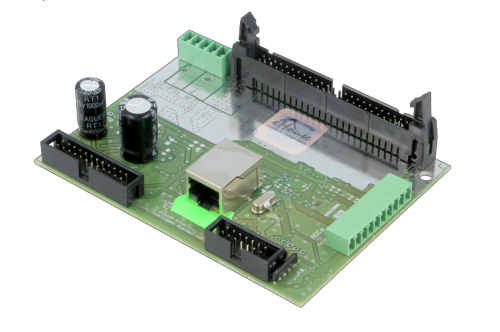 | .
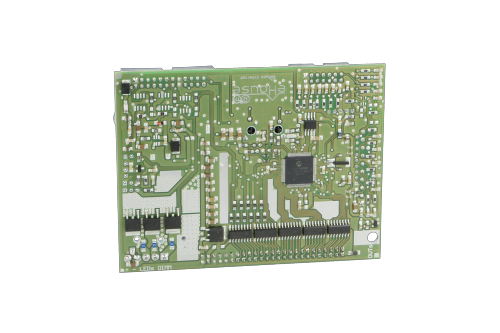 |
Relay modules (MP6-18) containing industrial relays+din-rail pads, replacing screw connections (allowing 45mm spacing between low and high voltages). Replaces dozens of patch cords. PCB can be cut to the required number of relays from 8..18.
Copper shorting rail (comb) for shorting the common contacts „COM” of the relays eliminates another few dozen wires. It can be cut to the required length.
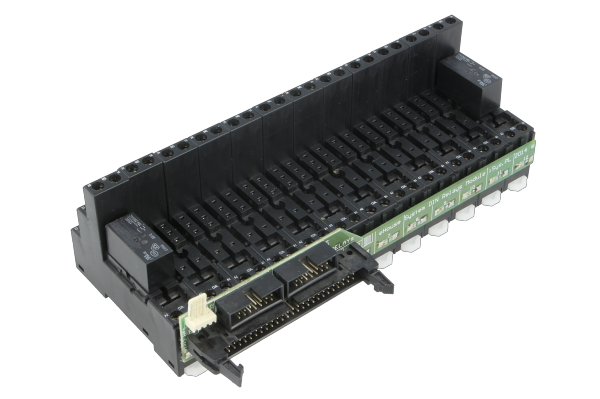 .
.
Professional switchgear 18-32 outputs 230V/16A. assembled eHouse LAN single segment switchgear: metal installation box with lock, LED power supply, mounting rails for simple installation.
 .
.
Wiring diagram for one eHouse LAN segment .
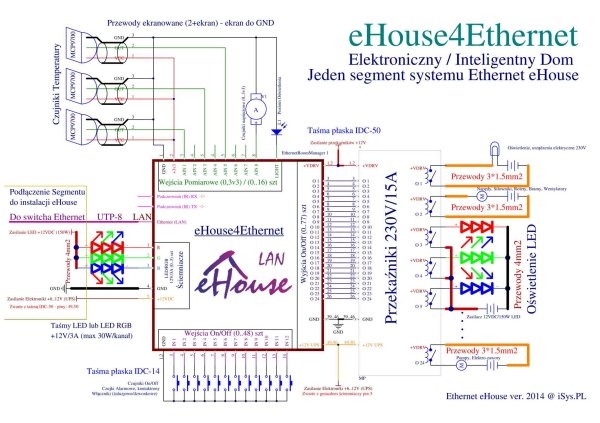 .
.
14) eHouse PRO - Central switchgear 128 binary inputs / 128 outputs with relays. .
System based on microcomputers (Raspberry PI 1..3, Banana PRO or similar). The eHouse PRO server software implements integrations of all eHouse variants. Multiple interfaces are provided for integration into the system in both directions TCP Client/Server, Modbus TCP/IP, SMS, HTML Request, File System, MySQL, Cloud, etc. Possible writing of software overlays for integration, dedicated algorithms for the eHouse system.
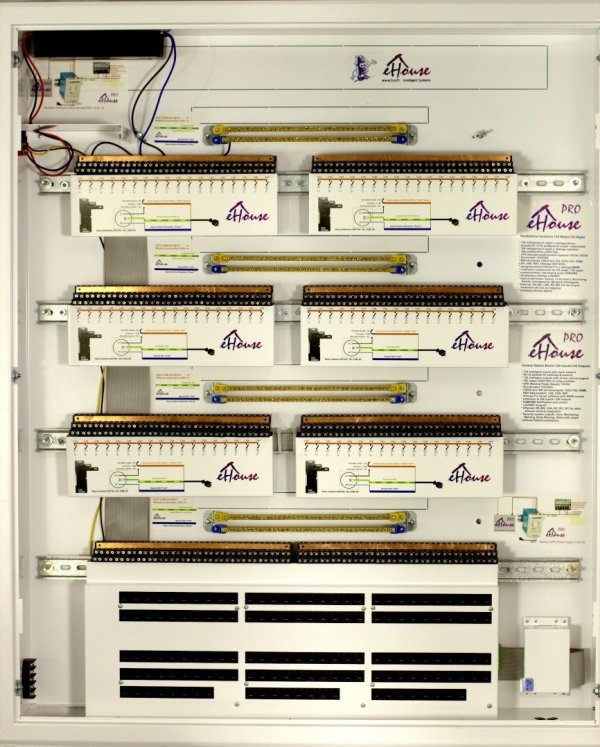 .
.
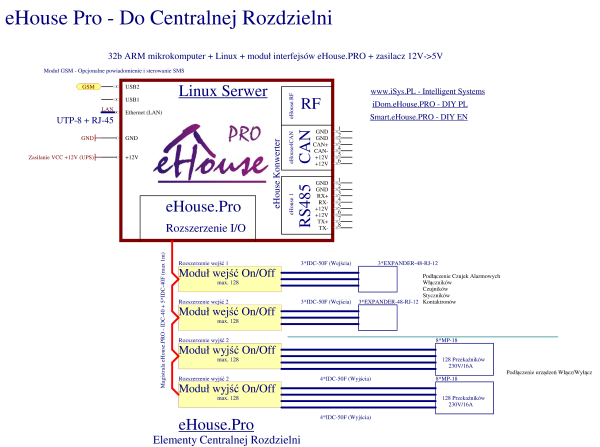
<br> 15) eHouse WiFi. .
Miniature controller „All-In-One” containing: up to 4 relay outputs, up to 4 binary inputs, 3 dimmers, IR input/output, measurement input, optional 230V power supply (OEM, DIY version). Works with eHouse LAN, PRO controllers in a common WiFi/Ethernet network.
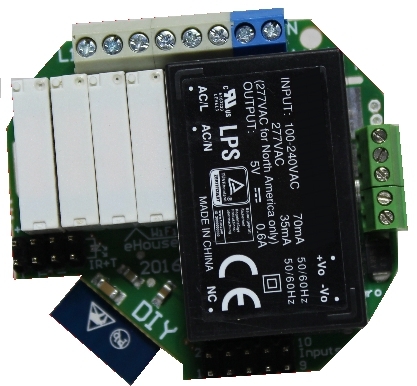 .
.
16) DIY modules for electronics „do it yourself”: .
Electronic modules for standalone smart systems based on RaspberryPi and clones and Autonomous WiFi controllers
DIY IOT: (WiFi ESP8266)
Extension of the WiFi ESP8266 module with external peripherals (relays, dimmers, power supply) for stand-alone operation.
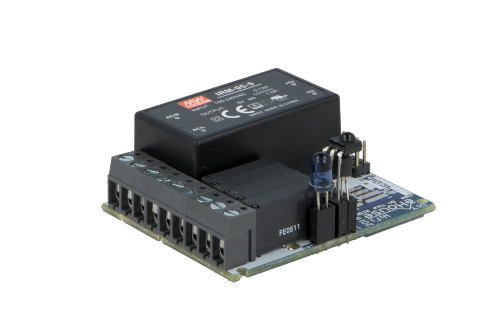 | .  |
DIY I/O SPI, I2C
I2C output modules (128) with relay drivers.
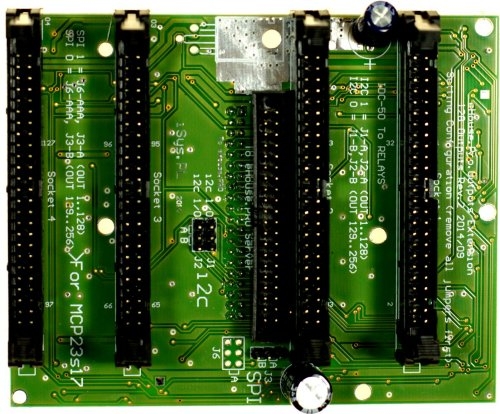 | . 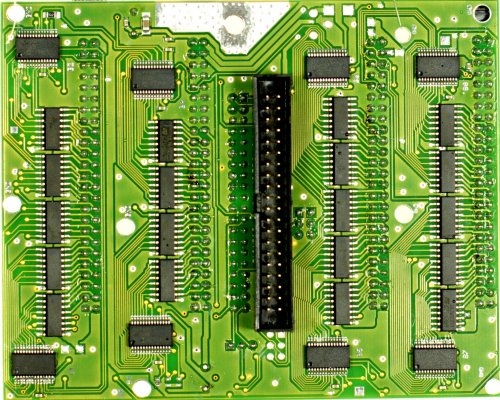 |
DIY SPI input modules (128) with 5 relay outputs.
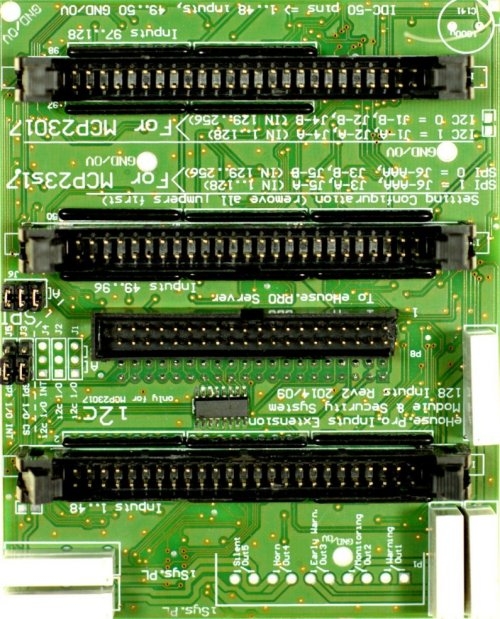 | DIY SPI input modules (128) with 5 relay outputs. 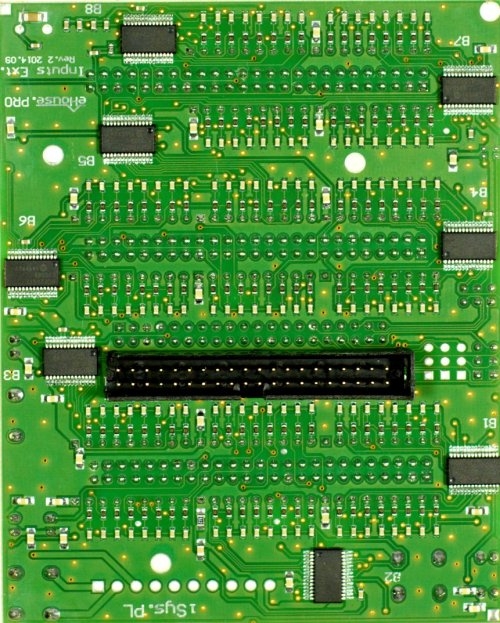 |
[on password „electrode” 10% discount for non-promotional DIY products up to 1.1.2018]
For installers additional discounts
.
For installers additional discounts
 | .
General information: http://ehouse.info/ Manufacturer's website: http://isys.pl/ . DIY Blog: http://idom.ehouse.pro/ Forum: http://ehouse.pro/forum/ Manufacturer's shop: http://eHouse.net.en/ | fc19b3fc6c1
Sponsored article. //gulson





